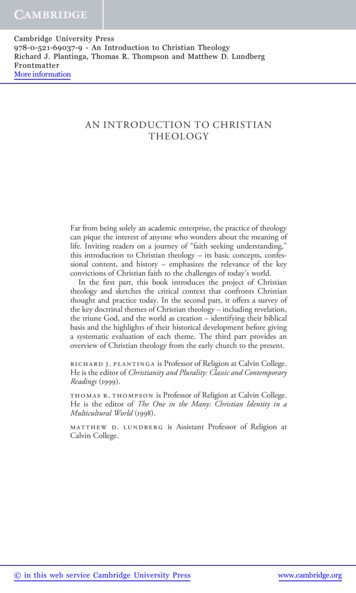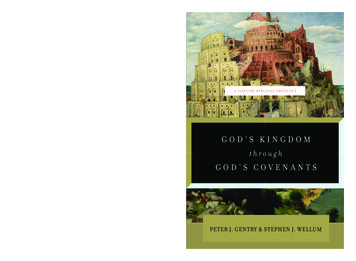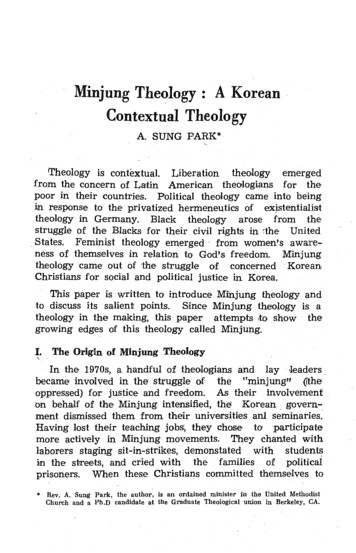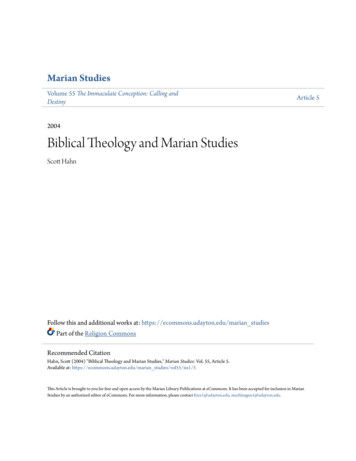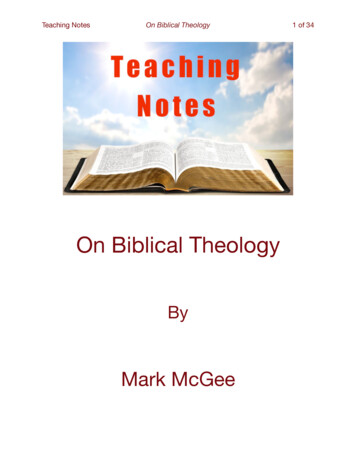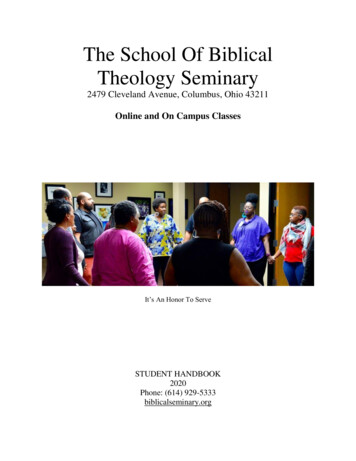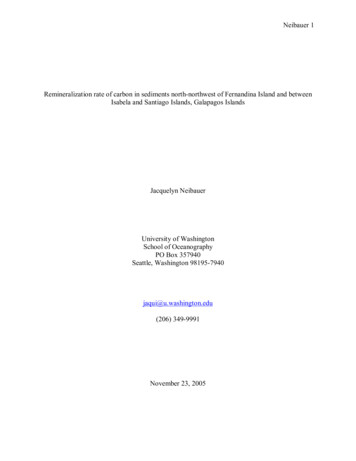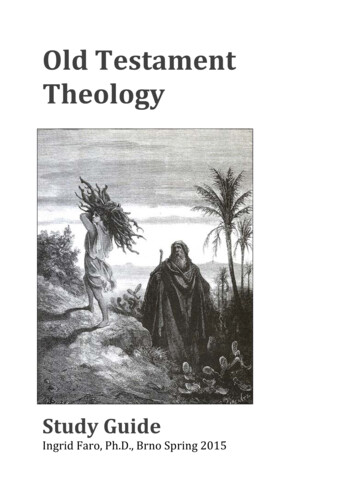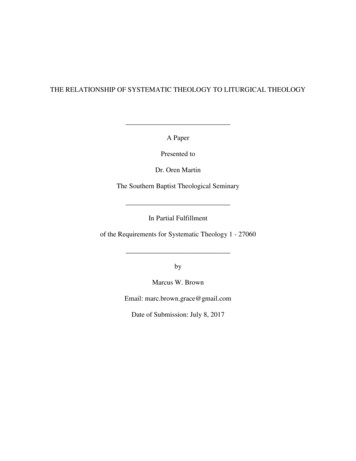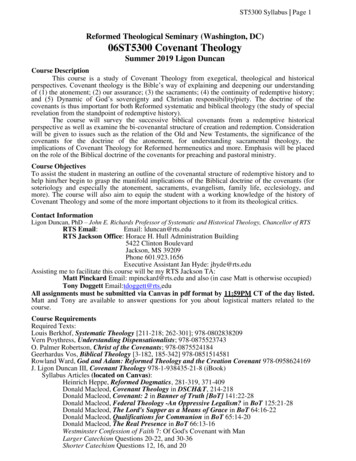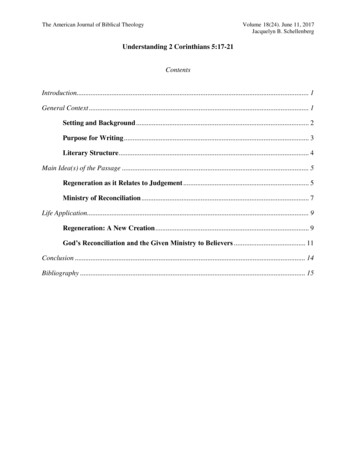
Transcription
The American Journal of Biblical TheologyVolume 18(24). June 11, 2017Jacquelyn B. SchellenbergUnderstanding 2 Corinthians 5:17-21ContentsIntroduction. 1General Context . 1Setting and Background . 2Purpose for Writing . 3Literary Structure . 4Main Idea(s) of the Passage . 5Regeneration as it Relates to Judgement . 5Ministry of Reconciliation . 7Life Application. 9Regeneration: A New Creation . 9God’s Reconciliation and the Given Ministry to Believers . 11Conclusion . 14Bibliography . 15
The American Journal of Biblical TheologyVolume 18(24). June 11, 2017Jacquelyn B. SchellenbergIntroductionThe goal of this paper will be to show how the “then and there”1 message within thepassage of 2 Corinthians 5:17-21 can be understood and applied in the “here and now”2. Thiswill be accomplished through the act of exegesis within the first and second sections andhermeneutics within the third, ending with a conclusion. The first section covers the matters ofgeneral context of the said passage and will attempt to answer the following questions so as toaid in understanding the passage: 1) “What is the purpose of the writer in this book?”3, 2) “Whatbasic problem was Paul addressing?”4, 3) “What was it like for people in that day?”5 and 4)“What were their attitudes and practices?”6. The proceeding section will attempt to address themain idea(s) presented by 2 Corinthians 5:17-19 and answer the question of “What was the Biblesaying through God’s human servant to the first hearers or readers of that message?”7. The thirdsection will examine the possible life application of said passage and address the question “Howshould we understand and apply the passage (if it should be applied) to the people of today?”8.This will then be followed by a conclusion.General ContextTo begin to understand the passage of 2 Corinthians 5:17-21 one must first identify theauthor, recipients and date written. This being said, the primary author of 2 Corinthians is the1. Gordon D. Fee and Douglas Stuart, How to Read the Bible for All Its Worth, (Grand Rapids, MI: Zondervan,2014), 27.2. Ibid.3. Berkeley A. Mickelson, and Alvera M. Mickelson, Understanding Scripture: How to Read and Study the Bible,(Peabody, Massachusetts: Hendrickson Publishers, 1992), 20.4. Ibid, 21.5. Ibid.6. Ibid.7. Ibid, 14.8. Ibid, 15.1
The American Journal of Biblical TheologyVolume 18(24). June 11, 2017Jacquelyn B. SchellenbergApostle Paul; however, Timothy is also mentioned as being alongside Paul thus showing hecould have also take an authorship role (2 Cor. 1:1 NASB/NIV).9 The epistle’s (letter’s)recipients are those of the church of God at Corinth as well as all the saints throughout Achaia (2Cor. 1:1; 9:2 NIV) with the most likely date for writing being late A.D. 55 or early A.D. 56 fromPhilippi.10 However, with regard to the church of God at Corinth, the only narrative (and onlyextra-Pauline) source is a limited passage in Acts (18:1–18 NIV) in which it notes that theCorinthian church was attempted to have been originated in a synagogue (Acts 18:5-8 NIV).11Setting and BackgroundIn proceeding to determine the setting of 2 Corinthians it can be identified that “the“occasional” nature of Paul’s letter invites some interpretive observations” as “ancient writers,like modern ones, typically assumed a measure of cultural and situational knowledge on the partof their audience”12. The public life in Corinth during Paul’s time was Roman although “many ofthe elite in Rome sough to it imitate Greek ways, most of the elite in Corinth would seek tosolidify their city’s identification with Rome. In view of this evidence, it is not surmising that ahigher than usual percentage of the names in Paul’s circle in Corinth are Latin”13. With thisbeing said though, the writing of Paul to Corinth was in Greek as 1) “even in Rome, educatedRomans studied Greek language and culture; still less could mercantile Corinth ignore itsenvironment”, 2) “despite its traditional base of Roman colonists, the city drew many immigrants9. Charles H. Talbert, Reading Corinthians: A Literary and Theological Commentary, (Macon, Ga: Smyth &Helwys Publishing, 2002, eBook Collection (EBSCOhost), EBSCOhost), 164.10. John MacArthur, The MacArthur Bible Commentary, (Nashville, TN: Thomas Nelson Publishers, 2005), 16121613.11. Craig S. Keener, 1-2 Corinthians, (Cambridge, UK: Cambridge University Press. 2005. eBook Collection(EBSCOhost), EBSCOhost), 8.12. Ibid, 6.13. Ibid, 7.2
The American Journal of Biblical TheologyVolume 18(24). June 11, 2017Jacquelyn B. Schellenbergfrom Greece and elsewhere in the eastern Mediterranean” and 3) “the congregation’s likelyJewish and God-fearing Gentile founding center (cf. Acts18:4) probably spoke Greek, as mostJews in Rome did”14. Thus, the need of both Greek and Roman elements of the time as thisknowledge aids understanding Paul’s correspondence with Corinth.15 In addition, to understandthe Greek and Roman elements present in Corinth one must also recognize the economicelements in Corinth which consisted of wealth and antiquity as its’ location has long involvedtrade; however, most Christians in Corinth were not well-to-do (1 Cor. 1:26 NIV).Purpose for WritingIn examining the reason for writing 2 Corinthians at surface level it appears that thepurpose lies in Paul’s desire to re-establish his convert’s trust in him and their intimate friendshipas noted by the The IVP Bible Background Commentary16; however, upon further examinationone can see there is more depth to the reason of writing as he also writes to defend andsubstantiate the ministry and authority he has been given. The Oxford Bible Commentaryexpands upon the matter in showing that the reason and situation for writing 1 Corinthians –Paul’s response to “problems involving community division and behavior, problems he felt wereincompatible with membership in Christ's body” was the precursor to the community issues of 2Corinthians which “extended to include the nature of the apostle’s relationship with theCorinthians”17. “Convinced that the relationship was severely threatened, and of the need forreconciliation, Paul set out to defend his apostolic authority”18. Thus, the nature of Paul’s14. Keener, 1-2 Corinthians,7.15. Ibid.16. Craig S. Keener, The IVP Bible Background Commentary: New Testament, (2nd Ed., Downers Grove, IL:InterVarsity Press, 2014, eBook Collection (EBSCOhost), EBSCOhost), 499.17. John Muddiman and John Barton, The Oxford Bible Commentary, (Oxford: OUP Oxford, 2007, eBookAcademic Collection (EBSCOhost), EBSCOhost), 1134.18. Ibid.3
The American Journal of Biblical TheologyVolume 18(24). June 11, 2017Jacquelyn B. Schellenbergauthority is a theme throughout 2 Corinthians where some of the specific issues underinvestigation include Paul's apostolic credentials and talents, his involvement in the collection forthe Jerusalem church and his attitude towards receiving material support from thecongregation.19 It can now be observed that Paul is aware of rival teachers who are presentingtheir credentials to the Corinthians and attempting to gain/earn their loyalty (2 Cor. 2:17NASB/NIV) as “Paul’s competitors likely boast letters of recommendation (3:1) and engage inself-commendation (5:12)”20. However, “if some Corinthians fail to recognize that they cannotbe on good terms with both Paul and his rivals (a situation unlike that in 1 Cor. 1:12), Paulmakes this demand clear in no uncertain terms.that they be reconciled with God, Christ, andwith Paul the divine agent (2 Cor. 5:20–6:2; 6:11–13), while breaking with “unbelievers”compromising with paganism (6:14–16)”21.Literary StructureWith this being said, the literary structure of the letter must be examined. While no onedisputes that 2 Corinthians is a letter, there is an issue of the book’s unity, specifically inreference to the change of tone from chapters 1-9 and 10-13 as is evident in both the NIV andNASB translations. The Oxford Bible Commentary states “it is a generally held view today that 2Corinthians in made up of more than one of Paul’s letters. Although there is no MS evidence tosupport this theory, there are several problems in the text as we have it which raise the questionof its unity Among the more serious difficulties is the sharp break between the conciliatory toneof chs. 1-9 and the harsh, sarcastic tone of chs. 10-13”22. To which The IVP Bible Background19. Muddiman and Barton, 1134.20. Keener, 1-2 Corinthians, 144.21. Ibid.22. Muddiman and Barton, 1134.4
The American Journal of Biblical TheologyVolume 18(24). June 11, 2017Jacquelyn B. SchellenbergCommentary believes “dividing 2 Corinthians into two letters is a possible way to read theevidence, but the burden of proof should remain on those who wish to divide it rather than onthose who argue for its unity”23. However, an alternate position to which I agree with claims “thebest interpretation views 2 Corinthians as a unified letter, with chapters 1-9 addressed to therepentant majority (cf. 2:6) and chapters 10-13 to the minority still influenced by the falseteachers”24 with support for this view being: 1) there is no historical evidence that chapters 10-13circulated as a separate letter, 2) the differences in tone between chapters 1-9 and 10-13 havebeen exaggerated (11:11; 12:14 with 6:11; 7:2 NASB) and 3) chapters 10-13 form a logicalconclusion to chapters 1-9 as Paul was preparing the Corinthians for his promised visit (1:15, 16;2:1-3 NASB).25Main Idea(s) of the PassageFrom the above, one may come to the conclusion of a dominate theme of 2 Corinthianswhich indicates that of Paul’s ministry as his main concerns in writing were 1) to defended hisministry and authority (chs. 1-7), 2) exhort the Corinthians to reassure their preparation for thecollection (chs. 8-9) and 3) confront the false teachers head-on (chs. 10-13).26 It is within thisoverarching theme that one will proceed to identify the main ideas/themes located in the passageof 2 Corinthians 5:17-19.Regeneration as it Relates to JudgementTo begin to understand the passage of 2 Corinthians 5:17-19, one must not only look tosaid passage, but also to the surrounding verses for context. This being said, verses 11-16 speak23. Keener, The IVP Bible Background Commentary: New Testament, 498.24. MacArthur, 1642.25. Ibid.26. Ibid, 1613.5
The American Journal of Biblical TheologyVolume 18(24). June 11, 2017Jacquelyn B. Schellenbergon the warnings against the reliance on external appearances, which relates verse 17 as “Paul’sministry to a reversal of earthly standards and the dawning of a new creation”27 with his motivesbeing rooted in the Christ event (2 Corinthians 5:13-17 NIV). Paul’s motives consist of firstbeing controlled by Christ’s love (v. 13-14 NIV), second being defined by Christ’s death as “thelove of Christ is defined in terms of his death for us, that death being looked at in terms of itsnecessity” (v. 14 NASB, “therefore all died” and its objective v. 15 NASB, “that they who livemight no longer live for themselves, but for Him”) and how the “love of Christ is defined by thefact that when a universal need existed, Christ died to meet it”28 and third the two-foldconsequences of living for Christ.29 Proceeding to verse 17, if the consequences of living forChrist constitute the formation of a “new creature” (NASB) or “new creation” (NIV) [eachtranslation constituting the same idea from the Greek word “ktisis” –“the act of creating” or “thecreative act in process”30 as it relates to the consequences of the creative act and refers toregeneration or new birth at a qualitatively new level of excellence. 31], the implications wouldthen be “that this radical change demands that all Christians, like Paul, judge by criteria thattakes motive into account. If the Corinthians understood the apostle’s motives, they would beable to answer those who judge merely on the basis of surface data”32. Paul extends his line ofthought by emphasizing newness as he rejects appearance and favors the heart, thus showing “hewas not interested in a fleshly perspective on Christ or Christians”33 (i.e. human perspective -27. Muddiman and Barton, 1140.28. Talbert, 198.29. Ibid, 199.30. James Strong, The New Strong’s Expanded Exhaustive Concordance of the Bible, (Nashville, TN: ThomasNelson Publishers, 2010) 146.31. MacArthur, 1630.32. Talbert, 199.33. Keener, 1-2 Corinthians, 185.6
The American Journal of Biblical TheologyVolume 18(24). June 11, 2017Jacquelyn B. Schellenberg“worldly point of view” (v. 16 NIV) and/or “according to the flesh” (v. 16 NASB)), “but in thehidden, eschatological reality of resurrection life that had begun in Christ’s resurrection.In further examination of verse 17, the words “in Christ” (NASB/NIV) comprise a briefyet profound statement of the significance of the believer’s redemption, which includes thefollowing: 1) the believer’s security in Christ, 2) the believer’s acceptance in Him, 3) thebeliever’s future assurance in Him, and 4) the believer’s participation with Him in the divinenature of Christ.34Ministry of ReconciliationIn verses 18-21 Paul speaks of how the ‘newness’ one experiences in Christ originatesfrom God through the process of reconciliation - where the world is the object of God’sreconciliation (v. 19 NASB/NIV) and God is the reconciler of the world (Rom. 5:10 NASB/NIV)with the means of this reconciliation being described as being “through Christ” (v. 18NASB/NIV)) and “in Christ” (v. 17 and 19 NASB/NIV). In comparing and contrasting the NewInternational Bible translation (NIV) and the New American Standard Bible (NASB) translationa discrepancy in verse 18 becomes noticeable as it relates to what is ‘from God’. The NIVtranslation states “All this is from God, who reconciled us to himself.” whereas the NASBtranslation utilizes the inclusion of the word ‘these’ – “Now all these things are from God, whoreconciled us to Himself.” which I conclude aids in clarity in both the present verse and priorverses. John MacArthur substantiates this in noting how “many modern translations add thearticle “these” before “things, which connects the word “things” to all that Paul has just assertedin verses 14-17”35. Through continuing to examine verse 18, it can also be noted that Paul34. MacArthur, 1630.35. Ibid.7
The American Journal of Biblical TheologyVolume 18(24). June 11, 2017Jacquelyn B. Schellenbergtransitions his appeal to the Corinthians to which he notes “all this” (v. 19 NIV) with regard tonew creation (5:17 NIV) comes from God as the result of reconciliation with God by Christ’sdeath (2 Cor. 5:14-15; Rom. 5:10, NIV/NASB) to which it is actualized by embracing theapostolic proclamation.36 It can then be observed that “the “ministry” of reconciliation is the lifegiving “ministry” of the new covenant (2 Cor. 3:6–9; 6:3 NASB/NIV)”37. Thus, “by means of thedoctrine of ‘reconciliation’ in v. 18-19 Paul presents God’s initiative, Christ’s role, and his ownmission”38 - that of being a ministry of reconciliation an ambassador of Christ (v. 20NASB/NIV) to which “in order to justify his mission and break with worldly standards, Paulultimately relies on support for his conviction that God has transformed the world radicallythrough Christ”39. And as an “ambassador who entreats the assembly (5:20) .Paul presents Godas his ultimate judge, but this passage functions as an indirect acknowledgment of the fact thatthe Corinthians have put Paul on trial, and of how important it is to Paul that the Corinthiansrecognize his authority”40. As noted by Craig S. Keener “the world has not yet becomecompletely a new creation (5:17) as the principle of apostolic ministry of reconciliation is onlyavailable to those who accept the message of Christ as it is offered by His agents”41. In theconcluding verse (v.21) of the passage of 2 Corinthians 5:17-21 which one has been examining,Paul resolves the “mystery and paradox of verses 18-20”42 through explaining how sinners canbe/are reconciled to God through His Son Jesus Christ. Therefore, within these fifteen words36. Keener, 1-2 Corinthians, 185.37. Ibid.38. Muddiman and Barton, 1141.39. Ibid.40. Ibid, 1140.41. Keener, 1-2 Corinthians, 186.42. MacArthur, 1631.8
The American Journal of Biblical TheologyVolume 18(24). June 11, 2017Jacquelyn B. SchellenbergPaul expresses “the doctrines of imputation and substitution like no other single verse”43 inwhich Paul’s ministry is summarized in addition to the Gospel.Life ApplicationIn the above sections, one examined the context of the main ideas within the passage of 2Corinthians 5:17-19 as they related to that of Paul’s ministry and the original readers of thebiblical period - “then and there”44. The the following sub-sections will seek to determine 1) howone should understand the passage, 2) what the passage means in the “here and now”45 and 3) ifand/or what can be applied within an individual’s life.Regeneration: A New CreationVerse 17 it states “Therefore, if anyone is in Christ, he is a new creation; the old hasgone, the new has come!” (NIV) It is through this regeneration – this new life-giving relationshipwith Christ through reconciliation that one can truly ‘find life’. But in examining the aboveverses, what characterizes the “old” and the “new” life? Once one is able to identify theseaspects, one can begin to more so fully embrace their new life as it can 1) give characteristics tostrive towards acting upon and cultivating and 2) provide the individual an alternate perspectiveas the characteristics/attributes began to further shape the individual and the individual’s spiritualdevelopment which will/should result in a desire to please God with one’s life rather than othersor one’s self (2 Cor. 5:14-15 NASB/NIV). This is seen as 1) “our ambition must be differentfrom that of others; instead of pursuing position, power, prestige, or wealth, we should seek theapproval of our God (2 Cor. 5:9)”46 and 2) “our presuppositions shape our perspective, our43. Ibid.44. Fee and Stuart, 27.45. Ibid.46. Kenneth Boa, Conformed to His Image, Grand Rapids, MI: Zondervan, 2001), 69.9
The American Journal of Biblical TheologyVolume 18(24). June 11, 2017Jacquelyn B. Schellenbergperspective shapes our priorities, and our priorities shape our practice”47. It is during thisprocess of becoming a ‘new creation’ (regeneration) that one should begin to assume a servant’sheart towards God and others. An example of this is modeled by Paul after his conversion as hispriorities were altered so as to where his priority became “to meet people’s spiritual needs”48(Acts 17:16; Rom. 1:13-16; 9:1-3; 10:1, NASB/NIV). This heart and/or priority shift has thepossibility to reveal an entirely new concept to some individuals as previously serving could beequated to serving oneself rather than serving out of genuine love for God and others (John13:35; Rom. 13:9; Gal. 5:22-23; 1 Tim. 1:5; 1 Cor. 12:1-3; 13, NASB/NIV).Furthermore, it can be seen that “when Christ’s death and resurrection for all is actualizedby faith there is a new way of living and this new way of living is characterized by a new way ofknowing”49. This new way of knowing can be equated with the veil (a representation of manbeing separated from God by sin) being torn within the temple upon Christ’s crucifixion and thegiving-up of His spirit (Matt. 27:50-51 NASB) with the experiences of one’s eyes being openedfor the first time through the process of reconciliation and regeneration. In other words, living inthe world prior to conversion is similar to our eyes being opened and one is able to see for thefirst time what was and has always been there – God on the other side of the veil as when the veiltore, light broke into darkness and the grace, mercy, love and peace of God came floodingthrough.However, this new way living and of knowing must be actively pursued as “to genuinelybelieve and embrace the reality of who we have become [new] as a result of our faith in Christ47. Ibid.48. MacArthur, 1630.49. Hulitt Gloer, "Ambassadors of reconciliation: Paul's genius in applying the gospel in a multi-cultural world: 2Corinthians 5:14-21." (Review & Expositor 104, no. 3 (2007 2007): 589-601. ATLA Religion Database withATLASerials, EBSCOhost), 591.10
The American Journal of Biblical TheologyVolume 18(24). June 11, 2017Jacquelyn B. Schellenberg[reconciliation] requires consistent discipline and exposure to the Word of God”50. It is thenthrough this ‘exposure to the Word of God’ one comes to further define their new identity inChrist as “Jesus derived his identity from his relationship with his Father”51. Thus, if one’s Lordand Savior seeks the Father’s Will (continuously) should one not also follow Hisexample/model?It is one’s identification with Christ which leads to and is the basis for one’s imitation ofChrist (Phil. 2:3-4 NIV).52 Therefore, by developing a biblical perspective (the model set forthby God and exhibited in Christ) one’s heart is trained for discerning God’s Will in addition tolearning to recognize the truth behind motivations and the danger in functioning outside of God’sWill as they cannot be known and/or realized without the act of seeking the truth from God’sWord.God’s Reconciliation and the Given Ministry to BelieversIn examining the nature of Paul’s ministry – “that of being an ambassador of Christthrough whom God makes his appeals”53 (1 Cor 1:17; 2 Cor 5:20, NASB/NIV), with regard tothe passage of 2 Corinthians 5:17-21 one must ask if this role of ambassador strictly applied toPaul then or does it also have an application to people now? If one looks to the meaning of theword ‘ambassador’ – Greek: “presbeuo”54 one can see it describes 1) to “act as a representative(fig. preacher)”55, and 2) ”an older more experienced man who served as a representative of aking from one country to another”56. With this definition in mind it can then be concluded in50. Boa, 35.51. Boa, 44.52. Ibid, 45.53. Talbert, 200.54. Strong, 209.55. Ibid.56. MacArthur, 1631.11
The American Journal of Biblical TheologyVolume 18(24). June 11, 2017Jacquelyn B. Schellenberglight of 2 Corinthians 5:18 and 20 that when Paul described his role, he was also in a mannerdescribing the role of all believers – that of being “a messenger representing the king of heavenwith the gospel, who pleads with the people of the world to be reconciled to God”57. Hulit Gloerrecognizes this as “while in one sense God has accomplished the reconciliation of the world tohimself, in another sense this reconciliation remains incomplete until it is appropriated by faith inthe lives of persons”58. And he continues to state, “God has given to us the ministry ofreconciliation (vv. 18b, 19c, 20).and now entrusts the announcement of this reconciliation tothose who have come to know it in their lives”59. To the people of today, this ‘announcement’and/or role of being an ambassador is the sharing of the gospel with family, friends, strangers –everyone, thus embracing and fulfilling the Great Commission (Matt. 28:18-20; Mark 16:15,NASB/NIV). And this role of being an ambassador and “the reality of the gospel forreconciliation must be realized in the concrete realities of daily life”60 as the enemy (Satan) anopponent such as Paul had, would love for believers to keep their faith secret.It is then through one’s call to be reconciled to Christ and to be ambassadors of Christthat one has “been given a response-ability, an ability to respond to or neglect these divineinitiatives”61 in which from a human standpoint one’s relationship with God is determined byone’s willingness to reciprocate as without an ongoing response of our personality to God’sone’s relationship with Him would be surface level or that of non-existent.62 One must live a lifeof example, such as Paul exhorted Timothy to do in 2 Timothy 4:12. While Timothy was young,it did not stop him from living for Christ and modeling Christ within himself. By living a life of57. Ibid.58. Gloer, 597.59. Ibid, 598.60. Ibid.61. Boa, 459.62. Ibid.12
The American Journal of Biblical TheologyVolume 18(24). June 11, 2017Jacquelyn B. Schellenbergexample as an ambassador of Christ, His light is on display for all to see (Matt. 5:14-16 NIV). Itis God’s desire for believers to participate in His purposes by being a part of what His Spirit isaccomplishing in the lives of people - He invites us to take an active role in furthering Hiskingdom and in the transforming of lives where outsiders become insiders to the family of Godby individuals being an ambassador of reconciliation.63 This is evangelism in action! All onedoes or does not say or does or does not do has the ability to affect individuals for eternity. Howone choses to live - for Christ or for self/others makes an impact in/on eternity. “Biblicalevangelism is a lifestyle to be lived, not a lesson to be learned; it is a process.”, a life-long andlife giving process.64 An example of how one is to live an evangelist lifestyle as an ambassadorof Christ is located in Christ himself (as previously noted). To Jesus everything was worldevangelism and His life was ordered by this/His objective.65 “Everything he did and said waspart of the whole pattern. It had significance because it contributed to the ultimate purpose of hislife in redeeming the world for God. This was the motivating vision governing his behavior. Hissteps were ordered by it”66. Should not also a believer’s life encompass such as well? WhileJesus was The Son of God, would we not be well to follow His example? Especially if in theprocess of being created and re-created (regenerated) through reconciliation (2 Cor. 5:17NASB/NIV) if it was done in God’s/Christ’s image (Gen. 1:26-27 NASB/NIV)? Kenneth Boasummarizes the above principle and application well in stating:Christ the visible expression of the invisible God, came to disclose the heart, the essence,and the being of the eternal God in the clearest way of all – personal revelation. And hehas called the church to personally manifest his life to the world. We are letters of Christ,“known and read by all men” (2 Corinthians 3:2-3). We are to be communicators of amessage the world desperately needs to hear, and this communication must take place not63. Boa, 59.64. Ibid, 396.65. Robert E. Coleman, The Master Plan of Evangelism, (Grand Rapids, MI: Baker Publishing Group, 1993), 17.66. Ibid, 18.13
The American Journal of Biblical TheologyVolume 18(24). June 11, 2017Jacquelyn B. Schellenbergonly with our lips but also with our lives. Our words must be authenticated by the qualityof our character, by the genuineness of our love and service of people, and by thecorporate love within the Christian community. Our friends without Jesus need to knowthat they are important to use for who they are and not because they are warm bodies wewant to persuade. This will be reflected in our words, attitudes, and actions.67ConclusionWithin this paper one has examined the context of the passage of 2 Corinthians 5:17-21and the 2 main ideas of regeneration and reconciliations as presented to the original readers. Inaddition, one has also considered the possible application of said main ideas as they can beapplied to current readers/believers. With the application points within the sections of“Regeneration: A New Creation” and “God’s Reconciliation and the Given Ministry ofBelievers” consisting of 1) cultivating the ‘new’ characteristics one is given as a new creationthrough the individual’s spiritual development as it relates to having a new perspective (servant’sheart)/order of priorities which is accomplished through consistent discipline and exposure toGod’s Word which leads to the formation of a biblical perspective and imitation of Christ and 2)through the process of being reconciled to God, one being called to be an ambassador(representative) of this ministry in which one is to implore evangelism in/to one’s daily life byutilizing the manner of modeling one’s reconciliation/faith in their lifestyle with such exampleoriginating in and exhibited by Christ during His time on earth. Thus, it can be identified the“then and there”68 message of 2 Corinthians 5:17-21 can be understood and applied in the “hereand now”69.67. Boa, 409.68. Fee and Stuart, 27.69. Ibid.14
The American Journal of Biblical TheologyVolume 18(24). June 11, 2017Jacquelyn B. SchellenbergBibliographyBoa, Kenneth. Conformed to His Image. Grand Rapids, MI: Zondervan. 200.Coleman, Robert E. The Master Plan of Evangelism. Grand Rapids, MI: Baker PublishingGroup. 1993.Fee, Gordon D. and Douglas Stuart. How to Read the Bible for All Its Worth., Grand Rapids, MI:Zondervan. 2014.Gl
main idea(s) presented by 2 Corinthians 5:17-19 and answer the question of “What was the Bible . Gordon D. Fee and Douglas Stuart, How to Read the Bible for All Its Worth, (Grand Rapids, MI: Zondervan, 2014), 27. 2. Ibid. 3. Berkeley A. Mickelson, and Alvera M. Mickelson, Understanding Scripture: H
